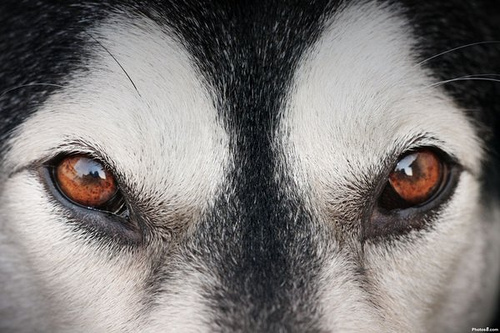
What is keratoconjunctivitis sicca (“Dry eye”, KCS)?
Keratoconjunctivitis sicca is a medical term for a condition that is more commonly known as “dry eye”. KCS is a deficiency of tear production, resulting in drying and inflammation of the cornea (the most superficial layer of the eye) and the conjunctiva. It is a very common condition of dogs, although cats can also be afflicted with dry eye.
What causes keratoconjunctivitis sicca?
There are a number of causes of KCS. The majority of cases are caused by immune-mediated destruction of the tear glands. Other sources of dry eye include:
• Drug toxicity: antibiotics such as sulphadiazine and sulphasalazine can cause temporary or permanent dry eye in some animals
• Drug-induced reaction: atropine and topical anesthetics temporarily reduce tear production
• Neurological impairment: damage to the nerves leading to the lacrimal glands (the glands that produce tears) can cause KCS
• Removal of the third eyelid
• Systemic disease (e.g. distemper)
• Chronic conjunctivitis
• Trauma to the tear glands
• Hypothyroidism
• Congenital disease (some dogs are born without lacrimal glands)
• Breed predisposition
In many cases of KCS, the cause of the condition is never found. However, this does not prevent the problem from being treated.
Which dog breeds are predisposed to KCS?
Although the method of inheritance is poorly understood, the following breeds of dogs have been associated with a higher than average prevalence of dry eye:
• American Cocker spaniel
• Bulldog
• West Highland white terrier
• Lhaso apso
• Shih tzu
• Pug
• Pekingese
What are the symptoms of keratoconjunctivitis sicca?
The clinical signs associated with KCS will depend on the extent and duration of the condition. Cats generally tend to be less symptomatic than dogs. The symptoms include:
• Conjunctivitis – reddening and swelling of the conjunctiva
• Squinting or blinking excessively
• A thick yellow or mucoid discharge from the eye
• Prominent third eyelid
• Ulceration or cloudiness of the cornea
• Secondary bacterial infections
• Impaired vision
If your pet is showing any signs of ocular disease, make an appointment with a veterinarian. Prompt treatment is essential to prevent permanent damage to the eyes.
How do veterinarians diagnose dry eye?
Keratoconjunctivitis sicca is most commonly confused with bacterial conjunctivitis. It is important that a veterinarian performs a thorough ocular examination when either disease is suspected. KCS can be diagnosed by a very simple test: the Schirmer tear test.
The Schirmer tear test involves sticking small strips of absorbent paper on the inside of the eyelid. The strips absorb tears and indicate the level of tear production present in the eye. If there are inadequate levels of tears present in the eyes, then KCS is confirmed. Because KCS frequently causes corneal ulceration, veterinarians should always evaluate the eyes for any signs of ulcers in addition to performing the Schirmer tear test. Ulcers can be diagnosed by instilling fluorescein dye into the eyes. The dye preferentially stains areas where ulcers occur.
What are the treatment options for KCS?
If the cause of the dry eye is known, then treatment should be aimed towards eliminating it. For instance, if sulfa drugs are being given, they should be stopped immediately. Unfortunately, in many cases, the cause of the KCS is never known. Most cases of KCS are managed rather than cured. Successful management requires long term commitment on the part of the pet owner. Treatment may include any of the following:
• Owners should thoroughly clean the eyes and keep them free of discharge, especially before applying medication
• Tear replacement: lubricating ointments and/or artificial tears are applied several times a day to keep the cornea moist
• Tear stimulation: topical Cyclosporine ointment (e.g. Optimmune) is the drug of choice for KCS, particularly for cases of immune-mediated KCS. The use of cyclosporine usually results in a significant rise in tear production.
Tear replacement and tear stimulation form the mainstay of therapy.
• Pilocarpine: oral or topical pilocarpine is occasionally used for neurological cases.
• Antibiotics: topical antibiotics may be necessary for animals with secondary bacterial infections or corneal ulcers
• Mucolytics: drugs that decrease mucus production or the viscosity of mucus
• Surgery: in cases that do not respond to medical treatment, surgical transposition of the parotid duct is an option. The parotid duct, which leads from the parotid salivary gland, is diverted into the lower conjunctival sac (i.e. the inside of the lower eyelid).
Thus, saliva acts as a substitute for tears. Because cyclosporine is such an effective drug, and saliva is a poor substitute for tears, this operation is rarely performed.
Pets should be regularly observed for any worsening of signs (e.g. increased discharge, squinting, rubbing at the eye). Patients should also be checked at regular intervals with the Schirmer tear test to ensure that therapy is effective. Most animals with immune-mediated KCS will require lifelong treatment. Other types of dry eye may be transient, and treatment need only continue until normal tear production resumes.
What happens if the dry eye is not treated?
Patients that do not have their condition treated will have ongoing pain and discomfort. Repeated eye infections and irritation to the cornea can cause severe damage. Ulceration and scarring of the cornea can eventually lead to blindness. The long-term prognosis for vision is greatly improved if the disease is diagnosed in the early stages. Prompt treatment is crucial. Always consult your veterinarian if your pet is showing signs of discomfort or discharge from the eyes.
(photo: photos8.com)